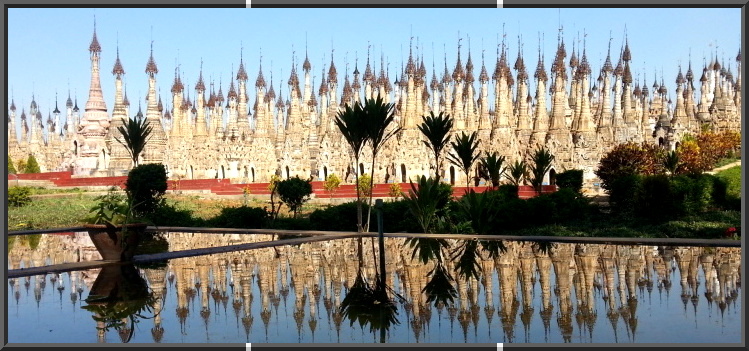|
|
 | | 
 |
|
YANGON
 Yangon was originally
a small fishing village called Dagon. Only
in 1755 King Alaungpaya renamed it Yangon that means “"End of Strife"”. One century later the city was annexed by the British, transformed into a
port town and declared their capital. The British pronounced and wrote
“Rangoon”. Today Yangon is the main gateway to Myanmar, a modern metropolis dubbed "Garden City of
the East" for its shady
trees and lush green parks. It
covers an area of 350 square km., with a population of about 5 million. Yangon has many attractions for visitors: the
magnificent Shwedagon Pagoda,
the Myanmar's most important, whose
history dates back more than 2,500 years ago and which was built to host eight Buddha’s hairs; old buildings from the colonial era; beautiful lakes; the
national museum and the lively Bogyoke market. Yangon was originally
a small fishing village called Dagon. Only
in 1755 King Alaungpaya renamed it Yangon that means “"End of Strife"”. One century later the city was annexed by the British, transformed into a
port town and declared their capital. The British pronounced and wrote
“Rangoon”. Today Yangon is the main gateway to Myanmar, a modern metropolis dubbed "Garden City of
the East" for its shady
trees and lush green parks. It
covers an area of 350 square km., with a population of about 5 million. Yangon has many attractions for visitors: the
magnificent Shwedagon Pagoda,
the Myanmar's most important, whose
history dates back more than 2,500 years ago and which was built to host eight Buddha’s hairs; old buildings from the colonial era; beautiful lakes; the
national museum and the lively Bogyoke market.
BAGO
 80 km. north-east of Yangon. From 1369–1539,
Hanthawaddy (former name of Bago) was the capital of the Mon Kingdom of Ramanadesa,
which included all of what is now Lower Burma. The
area came under Burman control again in 1539, when it was annexed by King Tabinshweti
to his Kingdom of Taungoo. The kings of Taungoo made Bago their royal capital
from 1539-1599 and again in 1613–1635, and used it as a base for repeated
invasions of Siam. As a
major seaport, the city was frequently visited by Europeans, who commented on
its magnificence. The Burmese capital was moved to Inwa in 1634. In 1740 the Mon revolted
and regained their independence, but Burmese King Alaungpaya conquered the city
again in 1757, thus bringing an
end to the short independence
of the Mon. Bago was
rebuilt by King Bodawpaya (r. 1782-1819) but by then the river had shifted
course, cutting the city off from the sea, and Bago never regained its previous
importance. 80 km. north-east of Yangon. From 1369–1539,
Hanthawaddy (former name of Bago) was the capital of the Mon Kingdom of Ramanadesa,
which included all of what is now Lower Burma. The
area came under Burman control again in 1539, when it was annexed by King Tabinshweti
to his Kingdom of Taungoo. The kings of Taungoo made Bago their royal capital
from 1539-1599 and again in 1613–1635, and used it as a base for repeated
invasions of Siam. As a
major seaport, the city was frequently visited by Europeans, who commented on
its magnificence. The Burmese capital was moved to Inwa in 1634. In 1740 the Mon revolted
and regained their independence, but Burmese King Alaungpaya conquered the city
again in 1757, thus bringing an
end to the short independence
of the Mon. Bago was
rebuilt by King Bodawpaya (r. 1782-1819) but by then the river had shifted
course, cutting the city off from the sea, and Bago never regained its previous
importance.
Places of
interest: Shwethalyaung Buddha
(Reclining Buddha), Shwemawdaw Paya, Kyaik Pun Paya, Kanbawzathadi Palace (site
and museum), Maha Kalyani Sima, Mahazedi Paya, Shwegugale Paya.
THANLYIN & KYAUKTAN
 Just 30 minutes' drive from Yangon and after
crossing Bago River, you will reach the old trading port of Thanlyin, invaded
by the Portuguese at the beginning
of the 17th century. Nowadays it is home to an international seaport. Among the most important sites of the city we can mention Kyaiuk Kauk
Pagoda and Shin Mwe Nonn Pagoda, on a hill overlooking Yangon. The main road through Thanlyin leads to another charming little town: Kyauktan. There is
a very famous pagoda
which attracts thousands of pilgrims,
called Ye Le. It is characterized by the fact that it was built on a tiny island in
the middle of the river, accessible only by boat. Just 30 minutes' drive from Yangon and after
crossing Bago River, you will reach the old trading port of Thanlyin, invaded
by the Portuguese at the beginning
of the 17th century. Nowadays it is home to an international seaport. Among the most important sites of the city we can mention Kyaiuk Kauk
Pagoda and Shin Mwe Nonn Pagoda, on a hill overlooking Yangon. The main road through Thanlyin leads to another charming little town: Kyauktan. There is
a very famous pagoda
which attracts thousands of pilgrims,
called Ye Le. It is characterized by the fact that it was built on a tiny island in
the middle of the river, accessible only by boat.
TWAN-TE
This is a small town on the Twan-te canal, about two hours by boat from Yangon.The boat trip itself is a pleasure and an opportunity to observe rural life along the canal. Agriculture and fishing are the main activities of the population. There are also many local products, such as rattan items, trays, screens, bamboo chairs etc... You can also visit pottery workshops and see many looms; weaving is in fact another traditional business of the area.
 |
|











 Just 30
Just 30